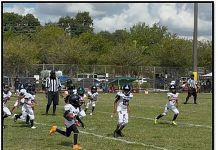As summer approaches and our children spend more time outdoors enjoying recreational activities, BSO would like to emphasize the first consideration should always be safety.
SWIM CENTRAL
Every day, about ten people die from unintentional drowning. Of these, two are children aged 14 or younger. Drowning ranks fifth among the leading causes of unintentional injury death in the United States. SWIM Central is the coordinating agency for water-safety instruction and awareness in Broward County. SWIM Central’s curriculumbased programs provide 10 free 30-minute water-safety classes over a two-week period, taught by certified water-safety instructors during the school day who have been carefully selected and trained through SWIM Central.
Contact SWIM CENTRAL at 954-357-SWIM (7946) or visit them online at: http://www.broward.org/PARKS/PROGRAMSCLASSES/Pages/ swimcentral.aspx
SKIN PROTECTION: A Guide to Protecting Kids When Activities Heat Up
Here’s a summer-bummer: a person’s sunlight exposure during childhood and adolescence is generally considered to increase the risk of early childhood skin cancer.
* Apply early and repeat. For kids six months and older (as well as adults), sunscreens with a Sun Protection Factor (SPF) of 15 or greater reduce the intensity of UVRs that cause sunburns. Apply liberally 15 to 30 minutes before sun exposure, so it can absorb into the skin and decrease the likelihood that it will be washed off. Reapply every two hours and after kids swim, sweat or dry off with a towel. For most users, proper application and reapplication are more important factors than using a product with a higher SPF.
* Cover. Dress kids in protective clothing and hats. Clothing can be an excellent barrier of ultraviolet rays. Many light-weight sun-protective styles cover the neck, elbows and knees.
* Keep infants out of the sun. Keep babies younger than six months out of direct sunlight, dressed in cool, comfortable clothing and wearing hats with brims. The American Academy of Pediatrics (AAP) says sunscreen may be used on infants younger than six months on small areas of skin if adequate clothing and shade are not available.
* Plan early morning play. For kids beyond that baby stage, parents should plan outdoor activities to avoid peak-sun hours (10 a.m. to 4 p.m.) as much as possible. Sound impossible for your active kids? Make sure you take a break from the sun, when needed.
* Beware of shade. Many people think sitting in the shade is a simple sun compromise. Shade does provide relief from the heat, but it offers parents a false sense of security about UVR protection. You can still get sunburn in shade, because light is scattered and reflected. A fair-skinned person sitting under a tree can burn in less than an hour.
* Check the weather. Look for the ultra-violet (UV) index (on a site like Weather.com) when planning outdoor activities; it predicts the intensity of UV light based on the sun’s position, cloud movements, altitude, ozone data and other factors. Higher UV index numbers predict more intense UV light.
SUNSCREEN SPF (SUN PROTECTION FACTOR) SPF is an abbreviation for “sun protection factor.” A sunscreen’s protection factor (SPF) is figured by comparing how long it takes sunscreen-protected skin to burn to the length of time it takes unprotected skin to burn. The higher the SPF, the more protection you get against UVB rays. According to the American Academy of Dermatology, a very legitimate source on the subject, the required level is SPF30.
*For regular, everyday use, what level sunscreen should we be wearing? The American Academy of Dermatology recommends that everyone apply a sunscreen with an SPF30 every day, and an SPF50 before participating in outdoor activities.
*SPF30 seems low compared to all the other SPF levels on the market. Why is this number so low? The number means that it would take 30 times longer to burn than not wearing any sunscreen. That means if it would take a minute to burn without sunscreen, it would take 30 minutes to burn after applying the recommended amount of SPF30. This is usually adequate for low levels of sun exposure.
*There are so many sunscreens that are topping SPF100. Does a super-high SPF become ineffective at a certain number? The FDA has recently recommended changing the sunscreen labeling to avoid this confusion. Soon the highest level available will be 50+.
*Should different skin tones wear different levels of SPF? Everyone should wear sunscreen since the sun causes skin cancer and aging in all skin types. The Academy does not recommend different levels depending on skin tone.
LOOK BEFORE YOU LOCK!
Heatstroke is the number one killer of children, outside of car crashes. That’s why the Administration for Children and Families has joined with the National Highway Traffic Safety Administration (NHTSA) to attempt to reduce these deaths by reminding parents and caregivers about the dangers of heatstroke and leaving children in hot cars. Cars heat up very quickly in Florida and even with a window rolled down a few inches, if the outside temperature is in the low 80s, the temperature inside a vehicle can reach deadly levels in as little as 10 minutes!
Young children under 4-years-old are particularly at risk because their bodies overheat more easily. Hyperthermia, or higher than normal body temperatures, can cause seizures, organ damage, brain damage, stroke or even death.






